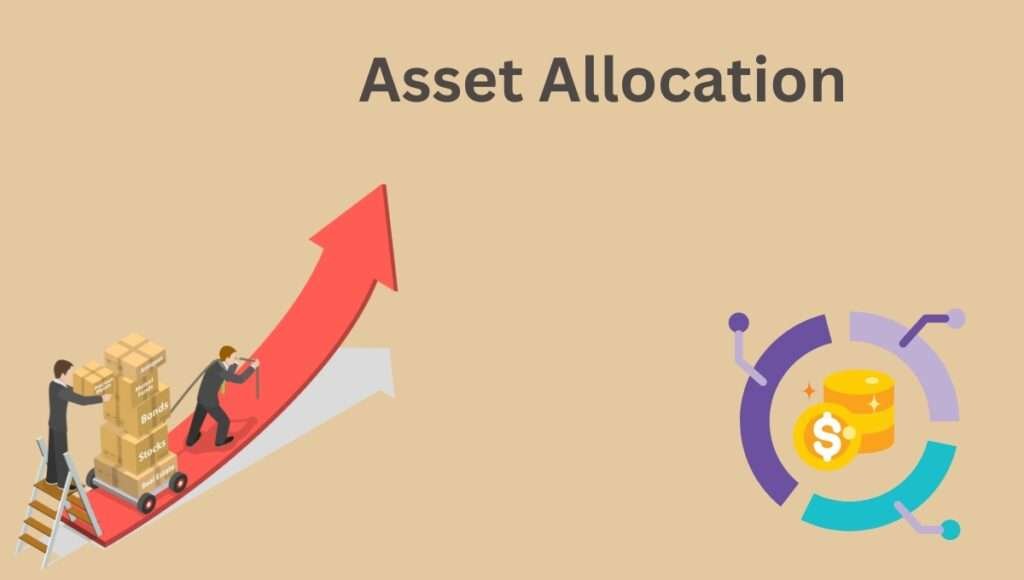
- Asset Allocation 101: What It Is and Why It Matters
Imagine your investment portfolio as a delicious pie. You wouldn’t want it filled with just one flavor, would you? Asset allocation is like creating the perfect pie filling – combining different ingredients (asset classes) to achieve a balanced and flavorful (profitable) outcome.
Here’s why asset allocation matters:
- Diversification is Key: Spreading your investments across different asset classes (stocks, bonds, real estate, etc.) helps manage risk. If one asset class performs poorly, others may pick up the slack, minimizing overall portfolio losses.
- Risk Management: Asset allocation allows you to tailor your portfolio to your risk tolerance. A younger investor with a long-term horizon might hold a higher percentage of stocks (higher risk, potentially higher reward). A retiree seeking income stability might favor bonds (lower risk, lower return).
- Long-Term Growth: By building a diversified portfolio, you’re positioned to benefit from the growth potential of various asset classes over time.
- The Risky Business of Putting All Your Eggs in One Basket
Have you ever heard the saying “don’t put all your eggs in one basket”? It perfectly applies to investing. Focusing on a single asset class is risky. If that asset class crashes (think the dot-com bubble or the 2008 housing crisis), your entire portfolio could suffer significant losses.
Here are some historical examples to consider:
- The Great Depression (1929): Overreliance on stocks led to devastating losses as the market plummeted.
- The Dot-Com Bubble (1999-2000): Tech-heavy portfolios took a major hit when the internet bubble burst.
Asset allocation helps you avoid these pitfalls by spreading your risk across different asset classes, ensuring your portfolio isn’t overly exposed to any single sector.
- Don’t Be Afraid of the “A” Word: A Beginner’s Guide to Asset Allocation
Asset allocation might sound complex, but it’s a simple concept with a big impact on your investment success. Here’s a breakdown for beginners:
- Step 1: Know Your Risk Tolerance: How comfortable are you with potential losses? Higher risk tolerance allows for more aggressive asset allocation (more stocks).
- Step 2: Define Your Investment Goals: Are you saving for retirement, a down payment, or a child’s education? Different goals require different allocation strategies.
- Step 3: Choose Your Asset Classes: Stocks, bonds, real estate, and commodities each have varying risk-return profiles. Select a mix that aligns with your goals and risk tolerance.
- Step 4: Rebalance Regularly: Market fluctuations can alter your asset allocation percentages. Periodically rebalance to maintain your target asset mix.
- Quiz: What’s Your Investor Risk Tolerance? (And How It Affects Asset Allocation
Your risk tolerance directly impacts your asset allocation. A conservative investor might hold a 70/30 allocation (70% bonds, 30% stocks). A more aggressive investor might choose a 60/40 split.
The quiz results will suggest a sample asset allocation strategy based on your risk profile. Remember, this is just a starting point – consult a financial advisor for personalized advice.
- Asset Allocation for Life’s Stages: From Young Grad to Retiree
Your investment needs and risk tolerance evolve throughout your life. Here’s a glimpse at how asset allocation can adapt to your life stage:
- Young Professional (20s-30s): You likely have a long investment horizon and can tolerate higher risk. An allocation of 80% stocks and 20% bonds might be suitable for long-term growth.
- Mid-Career (40s-50s): As you approach retirement, you might shift your focus towards income and preservation of wealth. Consider a 60/40 allocation (60% stocks, 40% bonds) or incorporate income-generating assets like dividend-paying stocks.
- Pre-Retirement (50s-60s): Here, stability becomes crucial. A 50/50 split or even a more conservative allocation (40% stocks, 60% bonds) might be appropriate to protect your nest egg.
- Retirement (60s+): Focus on generating income and capital preservation. Consider a balanced allocation with a higher bond percentage (30% stocks, 70% bonds) and explore inflation-protected securities.
Remember, these are just general guidelines. Consult a financial advisor to create a personalized asset allocation plan based on your specific circumstances.
- Busting Myths: Common Misconceptions About Asset Allocation
There’s a lot of misinformation floating around about asset allocation. Let’s clear the air on some common myths:
- Myth 1: Asset Allocation is Too Complex: It’s actually a simple concept. You can find online tools and resources to help you get started.
- Myth 2: Asset Allocation Guarantees Returns: No investment strategy guarantees returns. However, it helps manage risk and improve your chances of achieving your financial goals.
- Myth 3: Set It and Forget It: Markets fluctuate, so your asset allocation needs to adapt. Periodic rebalancing is crucial to maintain your target mix.
By understanding these myths, you can make informed decisions about your portfolio and avoid costly investment mistakes.
- Beyond Stocks and Bonds: Exploring Alternative Asset Classes
While stocks and bonds are the cornerstones of asset allocation, consider incorporating alternative asset classes for further diversification:
- Real Estate: Invest directly in property or through Real Estate Investment Trusts (REITs) for income and potential capital appreciation.
- Commodities: Commodities like gold and oil can act as a hedge against inflation but come with higher volatility.
- Private Equity: Invest in unlisted companies for potentially high returns, but this requires a high minimum investment and carries higher risk.
Remember, alternative assets should only make up a small portion of your portfolio unless you have a high-risk tolerance and a financial advisor’s guidance.
- Asset Allocation on Autopilot: Robo-Advisors and Target Date Fund
Don’t have the time or expertise to manage your asset allocation? Consider these automated solutions:
- Robo-Advisors: These online platforms use algorithms to create and manage your portfolio based on your risk tolerance and goals.
- Target Date Funds: These mutual funds automatically adjust your asset allocation as you near your target retirement date, becoming more conservative over time.
While convenient, these solutions might not be ideal for everyone. Robo-advisors may have limited investment options, and target date funds might not be suitable for those with specific investment needs.
- The Balancing Act: Rebalancing Your Portfolio for Optimal Performance
Imagine your portfolio as a see-saw. Over time, market fluctuations can cause one side (asset class) to rise, throwing the see-saw off balance. This is where rebalancing comes in.
Rebalancing is the process of periodically adjusting your portfolio back to your target asset allocation. For example, if your ideal allocation is 70% stocks and 30% bonds, but the stock market surges, your portfolio might become 80% stocks and 20% bonds. Rebalancing involves selling some stocks and buying bonds to get back to the 70/30 split.
Here’s why rebalancing is important:
- Maintains Risk Tolerance: Rebalancing ensures your portfolio stays aligned with your risk tolerance.
- Locks in Profits: By selling overperforming assets, you capture some of those gains and reinvest them in potentially undervalued assets.
- Boosts Long-Term Performance: Rebalancing can help you avoid emotional investment decisions and stay focused on your long-term goals.
- Asset Allocation Fails: Learning from the Mistakes of Others
History is full of investment blunders. Let’s learn from some common asset allocation mistakes:
- Overconfidence: Don’t be overly optimistic about your risk tolerance. Allocate based on reality, not just hope.
- Market Timing: Trying to predict market fluctuations is a recipe for disaster. Stick to your long-term asset allocation strategy.
- Neglecting Rebalancing: Regular rebalancing is crucial to maintain your desired risk profile and capture market opportunities.
By understanding these mistakes, you can make informed investment decisions and avoid pitfalls that could derail your financial goals.
- Asset Allocation for Different Investment Goals: Building Wealth vs. Saving for a Down Payment
The ideal asset allocation for your portfolio depends on your specific goals. Here are some examples:
- Building Wealth for Retirement: Focus on long-term growth with a higher allocation to stocks. Consider a 70/30 or 80/20 split (stocks/bonds) depending on your age and risk tolerance.
- Saving for a Down Payment: Prioritize short-term security with a higher bond allocation (60/40 or even 70/30 split). Consider using cash or cash equivalents for easier access to funds.
- Saving for College: Choose a balanced approach that prioritizes growth but considers some risk tolerance. A 60/40 or 50/50 split (stocks/bonds) might be suitable, with adjustments based on the time horizon until college.
Remember, these are just starting points. Consult a financial advisor to tailor an asset allocation strategy for your specific goals and circumstances.
- Asset Allocation for Socially Responsible Investors: Aligning Your Portfolio with Your Values
Do you want your investments to reflect your social and environmental values? Consider Socially Responsible Investing (SRI) and integrate it into your asset allocation:
- ESG Factors: Focus on companies with strong Environmental, Social, and Governance (ESG) practices.
- Sustainable Investing: Invest in companies promoting sustainability and positive social impact.
- Ethical Investing: Align your portfolio with your ethical principles by avoiding certain industries or companies.
SRI doesn’t necessarily mean sacrificing returns. Many SRI funds offer competitive performance while aligning your investments with your values.
- Don’t Let Emotions Cloud Your Judgment: The Psychology of Asset Allocation
Our emotions can significantly impact investment decisions. Here’s how to avoid letting them cloud your judgment:
- Fear: Avoid panic selling during market downturns. Stick to your long-term plan and remember that markets are cyclical.
- Greed: Don’t chase hot trends or get swept up in market euphoria. Base your decisions on sound investment principles and asset allocation strategy.
- Overconfidence: Don’t assume you can outperform the market consistently. Asset allocation helps manage risk and promotes discipline.
By understanding the psychology of investing, you can make rational decisions based on logic, not emotions.
- Asset Allocation Hacks: Tools and Resources to Simplify Your Investment Journey
There are numerous tools and resources available to simplify asset allocation:
- Online Asset Allocation Calculators: These tools help you determine an initial asset allocation based on your risk tolerance and goals.
- Investment Apps: Many investment apps offer built-in portfolio allocation features and automated rebalancing options.
- Financial Planning Software: Advanced software can help you create a comprehensive financial plan, including asset allocation strategies.
Take advantage of these tools to make informed investment decisions and streamline your portfolio management.
- Asset Allocation on a Budget: Smart Strategies for Small Investors
Building a diversified portfolio might seem daunting with limited funds. However, smart strategies can help:
- Low-Cost Index Funds: These passively managed funds offer broad market exposure at minimal expense ratios, ideal for long-term investors.
- Fractional Share Investing: Invest in portions of expensive stocks, allowing you to diversify even with limited capital.
- Dollar-Cost Averaging (DCA): Invest a fixed amount of money at regular intervals, averaging out the cost per share and mitigating market fluctuations.
Remember, starting early and investing consistently is key. Even small contributions can grow significantly over time with a well-diversified asset allocation strategy.
- Asset Allocation for the Long Haul: Building a Portfolio for the Future
Don’t get caught up in the short-term market noise. Here’s how asset allocation fosters a long-term perspective:
- Weathering Market Storms: Diversification helps you weather market downturns. While some assets might decline, others can offer stability or even growth.
- Focus on Goals: Align your asset allocation with your long-term goals (retirement, college savings). Don’t get sidetracked by short-term gains or losses.
- Time in the Market vs. Timing the Market: Focus on staying invested for the long haul rather than trying to predict market peaks and valleys. Asset allocation helps you remain disciplined and focused on your long-term goals.
By adopting a long-term perspective and a well-diversified asset allocation, you can build a resilient portfolio that grows with you over time.
17. Asset Allocation and Taxes: Strategies for Minimizing Your Tax Burden
Taxes can nibble away at your investment returns. Here’s how asset allocation can help:
● Tax-Advantaged Accounts: Utilize tax-advantaged accounts like IRAs and 401(k)s to shield your investments from current taxation.
● Tax-Efficient Asset Location: Place assets with higher tax implications (e.g., taxable bonds) in tax-advantaged accounts and vice versa.
● Consult a Tax Professional: Seek professional guidance for personalized strategies to minimize your tax burden and maximize your investment returns.
Remember, tax laws can be complex. Consulting a tax advisor can ensure you’re optimizing your asset allocation for tax efficiency.
18. DIY vs. Professional Help: Deciding How to Manage Your Asset Allocation
Do you go it alone or seek professional help with asset allocation? Let’s weigh the options:
● DIY Approach: Online tools and resources can help you get started. This path requires discipline and ongoing research.
● Financial Advisor: A professional offers personalized guidance, investment expertise, and ongoing portfolio management. Consider factors like fees and experience when choosing an advisor.
The best approach depends on your comfort level, financial knowledge, and investment goals. Don’t hesitate to consult a financial advisor if you feel you need professional guidance.
19. Asset Allocation for International Investors: Navigating Global Markets
Investing beyond your home country can add diversification and growth potential. Here’s how to adjust your asset allocation for international markets:
● Currency Diversification: Consider incorporating foreign currencies into your portfolio to hedge against currency fluctuations.
● Global Asset Classes: Explore international stocks and bonds for exposure to different economies and growth opportunities.
● Geopolitical and Economic Factors: Stay informed about global events that could impact international markets.
International investing comes with additional complexities. Consulting a financial advisor with expertise in global markets is highly recommended.
20. The Evolving Landscape of Asset Allocation: Adapting to a Changing World
The investment landscape is constantly evolving. Here’s how to keep your asset allocation strategy relevant:
● Emerging Trends: Stay informed about trends like cryptocurrency and fintech platforms that might impact traditional asset classes.
● Ongoing Research: Continuously evaluate your risk tolerance and investment goals. Revisit your asset allocation periodically to adapt to changing circumstances.
● Professional Consultation: Financial advisors can help you navigate an evolving investment landscape and adjust your asset allocation accordingly.
By staying informed, adapting your strategy, and seeking professional guidance when needed, you can ensure your asset allocation remains effective in a dynamic investment world.
Conclusion: Mastering the Art of Asset Allocation
Asset allocation may seem like a complex concept, but it’s a powerful tool for building a strong and resilient investment portfolio. By understanding the core principles, exploring different strategies, and adapting to your unique circumstances, you can navigate the ever-evolving investment landscape with confidence.
This blog series has equipped you with valuable knowledge on asset allocation. Remember, this is an ongoing journey. Stay informed, revisit your strategy regularly, and don’t hesitate to seek professional guidance if needed. With a well-diversified asset allocation as your foundation, you’ll be well on your way to achieving your long-term financial goals.


Leave a comment